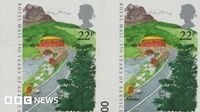Collectors and history buffs alike are abuzz this week as two extraordinary auctions have thrust rare British artifacts into the spotlight—one a violin once played by Albert Einstein, the other a pair of nearly forgotten 'error stamps' from the Royal Mail. Both sales, held on consecutive days in early October 2025, have drawn international attention for their remarkable backstories and eye-popping price tags.
On October 8, 2025, the Gloucestershire-based Dominic Winter Auctioneers hosted the much-anticipated sale of an 1894 Zunterer violin, believed to be the very first violin owned by Albert Einstein. According to BBC Gloucestershire, the instrument fetched £860,000 under the hammer—nearly triple its initial estimate of £300,000. But that’s not the end of the story. With the auction house’s 26.4% commission tacked on, the final price will soar above £1 million, making it potentially the highest sum ever paid for a violin not linked to a concert violinist or the famed Stradivarius makers.
The violin’s journey to the auction block is as fascinating as its price tag. In late 1932, Einstein entrusted the violin, along with a philosophy book and a bicycle saddle, to his close friend and fellow physicist Max von Laue. The timing was no coincidence: Einstein was preparing to flee Germany for America, escaping the rising tide of antisemitism and the threat of Nazism. Von Laue, a Nobel laureate himself, safeguarded the items for two decades before passing them on to Margarete Hommrich, an acquaintance and devoted Einstein admirer. Fast forward another generation, and it was Hommrich’s great-great-granddaughter who decided to bring the collection to auction in 2025.
While the violin commanded headlines, the accompanying philosophy book—gifted by Einstein—sold for a more modest £2,200. The bike saddle, however, failed to find a buyer and may be re-listed at a future date, according to the auctioneers.
Einstein’s relationship with music is well documented. He was known to play the violin throughout his life, finding solace and inspiration in its melodies. As BBC Gloucestershire notes, another violin once owned by the theoretical physicist, which was presented to him upon his arrival in the United States in 1933, fetched $516,500 (£370,000) at a New York auction in 2018. The latest sale, however, eclipses all previous records for Einstein-owned instruments, underscoring the enduring fascination with his legacy—and the premium that collectors are willing to pay for a tangible piece of it.
But Einstein’s violin wasn’t the only historic artifact making waves in the auction world this week. On October 9, 2025, JC Auctions in Jersey prepared to offer a pair of British 'error stamps'—tiny pieces of postal history with a story every bit as compelling as their scientific counterpart.
Issued in 1985 to commemorate 350 years since King Charles I opened the Royal Mail to the public, these 22p stamps were designed by the renowned illustrator Paul Hogarth. They depict the iconic Royal Mail Postbus, a once-familiar sight traversing rural Britain. But there’s a twist: due to a printing mishap, one sheet of 100 stamps was produced without the usual perforations that separate each stamp. The error was discovered, and the sheet was supposedly destroyed. Yet, as fate would have it, one pair survived the pulping process.
Though their combined face value is a mere 44p, these stamps are expected to fetch a sum that would make any collector’s heart race. The last time they went under the hammer, in 2014, they sold for £22,000. Mike Hall of JC Auctions told BBC News, "It's remarkable how two 22p stamps are worth £22,000 based on a mistake made by the printer—that is the extraordinary nature of stamp collecting." He added, "Our conservative estimate is £5,000. I wouldn't be shocked to see it surpass the £22,000 it made in 2014. It's so rare and desirable. You just need two determined bidders."
What makes these stamps so valuable? In the world of philately, missing perforations are a big deal. As Hall explained, "The missing perforations may seem like a small issue but they're a huge deal in stamp collecting." The rarity factor is compounded by the stamps’ nostalgic appeal, with their vivid depiction of the Postbus—a service that ran from 1967 to 2017, ferrying both passengers and mail across more than 200 rural routes in the UK. In a quirky twist, passengers on the Postbus could even pay their fare using postage stamps, a practice that now feels like a relic from another era.
The story behind these stamps is as much about British history as it is about human error and serendipity. Designed to celebrate a milestone in public communication, they ended up becoming a collector’s dream precisely because of a printing blunder. According to JC Auctions’ account, the printers intended to destroy the faulty sheet, but this lone pair "miraculously... escaped." Their survival is a testament to the unpredictable journey that rare collectibles can take, from the factory floor to the auctioneer’s podium.
Together, the sales of Einstein’s violin and the error stamps highlight the enduring allure of objects that connect us to pivotal moments in history—whether those moments are scientific breakthroughs, royal decrees, or simple accidents of production. For collectors, it’s not just about the monetary value, but the stories these items carry. As Hall put it, "The stamps themselves are beautiful and nostalgic, that adds to their appeal." The same could easily be said of Einstein’s violin, an instrument that once echoed with the music of a genius who changed the way we see the universe.
While the violin’s new owner remains anonymous, and the fate of the error stamps will soon be decided by the highest bidder, both auctions have already left their mark. They remind us that history is not just something to be studied in books—it’s something that can be held, played, and, sometimes, accidentally created. For those who chase these rare treasures, every bid is a chance to own a piece of the past, and perhaps, to keep its story alive for generations to come.
